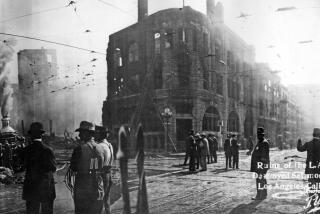Look Back in Anger
SOUTH ROYALTON, VT. — Something important is missing from the personal history of the man the FBI claims is the Unabomber. The bombs were meticulously crafted, ingeniously disguised. The targets implied an obsession with computers, technology, airlines, corporate “enemies” of the environment. The 18-year span of the bomber’s lethal campaign suggests a deeply rooted anger that could not be assuaged. What’s missing is the source of that rage.
Photos of the FBI’s suspect, Theodore J. (Ted) Kaczynski, beginning with a high-school photo in 1958, show the aging of a proud, tight-lipped man whose glare seems to hold the world at a distance. The last in the series, Kaczynski’s FBI mug shot after his arrest in April, has a wild, sullen look, as if the anger that drove him had coarsened over the years. It is the set of the jaw that arrests our gaze, teeth clenched, as if challenging the world to drag out the words that explain his acts.
Murder, like anger, is as old as Cain, but technology gives modern killers the power to kill on a scale far exceeding the reach of one man with his hands on the throat of another. This is bad news for a society where the level of anger is both high and rising--not just personal anger of the sort that begins to fester in childhood, but social anger, where the injury may be inflicted by impersonal forces or some item on the news. Timothy McVeigh, charged with the Oklahoma City bombing that killed 168 people, allegedly picked the date of his attack to commemorate the immolation of David Koresh and his followers in Waco, Tex.
Kaczynski and his lawyer both say he is not the Unabomber, and federal prosecutors will have to prove their case in court. But the evidence discovered in Kaczynski’s cabin--notebooks filled with diagrams for bombs, materials for making bombs, an assembled bomb, the typewriter that apparently typed the manuscript of the Unabomber’s manifesto--strongly suggests the public career of the Unabomber is at an end.
While the FBI was searching for the culprit, they put together a psychological portrait with a hazy focus, missing as much as it spotted. A few things were right on the money--for example, that he came from or had lived in Chicago and Berkeley. On some points, the FBI psychologists were plain wrong--they thought he was only a high-school graduate; he has a Harvard BA and PhD in math from the University of Michigan. Vaguest of all was the FBI’s guess at the core of the Unabomber’s soul; they figured he was a loner with a grudge. Well, yes--but a grudge about what?
Psychology is, at best, an inexact science, but it makes some fundamental assumptions: one is that you can’t get something from nothing. If anger is what comes out, then at some point anger went in. There has been plenty of anger on the front pages lately, personal anger that comes out of personal history. In Scotland, a man with a history of what social workers call an “inappropriate” interest in children burst into a school and shot 16 children to death before turning the gun on himself. In Oakland, a 6-year-old boy is charged with attempted murder after allegedly tipping a month-old baby out of its bassinet and kicking and stomping it before stealing a tricycle. In Australia, a young man with a history of “mental problems” went on a shooting spree that left 35 dead. In Middlebury, Vt., an hour from my house, a man shot two people and then himself in an episode that made little impression beyond the range of local papers because the nature of the case has grown so (distressingly) routine.
In each of these cases, the motive for murder appears to have come solely from the killer’s (or aspirant killer’s) personal history. What horrifies is the ferocity of the response to some purely private hurt.
Literary critics have long debated what lies at the root of the poisonous insinuations of Iago in William Shakespeare’s “Othello.” A jealous rage, artfully encouraged by Iago, prompts Othello to murder his beloved Desdemona, then kill himself--a pattern of sexual murder increasingly common on police blotters. The mystery in the play is what drives Iago; “motiveless malignity”--the trait theologians once called “evil”--is how some critics have described it. The killers in Scotland and Australia and the monstrous 6-year-old all seem to share Iago’s desire to inflict pain for its own sake, for no reason, but blindly, out of their own nature, as the wind howls.
What distinguishes the Unabomber--Kaczynski, if it’s he--from these other compulsive killers is that he claims to be driven by social anger, moral and intellectual rejection of the basic premise of Western democratic society: that technology gives everybody more, and more is good. The Unabomber’s views on this were spelled out in the 35,000-word manifesto he persuaded the New York Times and Washington Post to print last year. There, he said flatly: “The Industrial Revolution and its consequences have been a disaster for the human race . . . . The single overriding goal must be the elimination of modern technology.”
This sounds odd coming from a man skilled in the use of computers; a meticulous fabricator of highly sophisticated explosive devices; a man who called a plywood cabin home and sponged on his brother whenever he needed money. Much about Kaczynski’s life suggests human isolation rather than political rebellion; his windowless cabin did not place him in nature as much as it sealed him off from the world. In 1978, he began harassing a woman who spurned a relationship, forcing his brother to fire him from one of the few jobs he ever held, and a dozen years later he refused to attend his father’s funeral. But, at the same time, in letters to a Mexican farmer, he complained of loneliness and wished for a wife and family. There is plenty of evidence of a tortured inner life.
But the Unabomber’s manifesto says his goal is a kind of revolution in reverse, and he killed three men and wounded 23 others in a crazy attempt to shock the U.S. public into rethinking its dependence on technology. This is what 19th-century bomb-throwing anarchists, who invented the strategy, called “propaganda of the deed,” and like the Oklahoma City bombing a year ago, it was intended, and should be seen, as a political act.
Modern political terrorism had its roots in the aftermath of World War II in Palestine, where Arab and Jewish underground groups attacked the British and each other. Succeeding waves of terrorism have since touched every corner of the globe, with one exception: The United States, both the most violent and most heavily armed civilized country on Earth, has been largely spared the terror campaigns that have swept France, Ireland, Italy and the Middle East. In the 1960s, white racist groups in the South bombed black churches, and in the 1970s, white radical groups set off a few bombs to prove all was not serene in the homeland of capitalism. But real terror was missing.
Now that may be changing. The Unabomber claimed to speak in the name of an organized movement--but investigators were apparently right in their guess that he plotted alone. But they were wrong when they guessed his bombing was the result of a grudge, meaning a desire for revenge of a personal slight. The Unabomber’s grudge, if grudge it can be called, is on the grand scale, directed against an entire society--and in this he is far from alone. The so-called freemen holed up in Montana, the hundreds of militia groups arming for Armageddon, the Aryan white supremacists and gun fanatics who think they’re being followed by the Bureau of Alcohol, Tobacco and Firearms are walking time bombs of social anger waiting to explode.
Somewhere in Kaczynski’s past, if prosecutors are right, is that primal hurt that gave him what most Americans lack--the ability to kill. Some psychologists suspect the injury occurred in his first year--doctors isolated him for treatment of an allergy at a stage of infancy when fundamental bonds of human connection are forged in the eye contact and touching between mother and child.
But we should not forget the Unabomber’s manifesto, burning with passionate resentment of the material world built by American finance and industry. If what you hate is urban sprawl, parking lots, factories like football fields, damned rivers, power lines, multilane highways shouldering aside mountains and multiengine jets streaking the pristine sky over dwindling pockets of wilderness, then there is plenty to hate. Add the traditional American genius for mechanical tinkering, the obsession with guns and violence, the dislike of foreigners and distrust of government, and we have assembled, at last, the ingredients for home-grown terrorism. Bombs are not much good for pressing complex political agendas, but they are ideal for expressing anger.*
More to Read
Sign up for Essential California
The most important California stories and recommendations in your inbox every morning.
You may occasionally receive promotional content from the Los Angeles Times.










